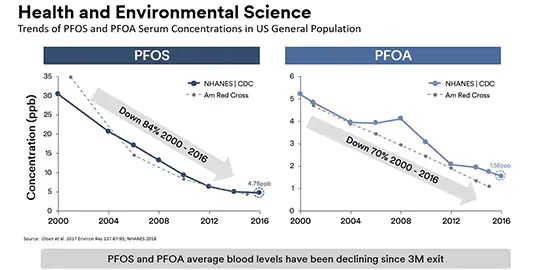How Fluorochemistries Are Safely Used
Frequently Asked Questions
 |
3M cannot provide, and this page is not intended to provide, medical advice to individuals. Readers with personal health questions concerning PFAS should consult with their respective physicians.
Q: Is it true that PFOS and PFOA are highly toxic and dangerous?
A. PFOA and PFOS have been widely studied for decades. Studies of people who worked with these substances every day in their jobs, including 3M’s own employees, have not found that these materials cause adverse health outcomes in people. While some research shows that these materials are associated with negative health outcomes at very high levels, other studies don’t reach the same conclusions.
Overall, the body of scientific evidence does not show these materials cause harm to people at real-world levels.
Overall, the body of scientific evidence does not show these materials cause harm to people at real-world levels.
Q. Do I need to avoid exposure to PFOA or PFOS for my safety?
A. 3M cannot provide individuals medical advice, because everyone’s health is different. However, the body of scientific evidence does not show these materials cause harm to people at real-world levels. In addition:
- PFOA and PFOS have been phased out of manufacturing in many countries, including the United States, for years. Levels of these materials in people have been steadily declining for decades.
- In areas where PFOA or PFOS are present at high levels in drinking water, there are readily-available technologies that can reduce these levels.
Q. Do PFOA or PFOS cause cancer?
A. Scientific evidence does not show PFOA or PFOS cause cancer at levels found in people.
Q. Why does some media reporting indicate that PFAS are dangerous to peoples’ health?
A. While we can’t speculate about all media reporting, many of the scientific studies and ideas referenced in media reporting are complex and require careful review to understand the nuances of their findings. For example:
- Some media have indicated that PFAS exposure is associated with adverse effects in animals – but do not include information about the extremely high doses these animals were exposed to.
- Other media stories focus on research that shows a link between PFAS and negative health conditions, but don’t reference other studies don’t reach the same conclusions. Overall, the body of scientific evidence does not show these materials cause harm to people at real-world levels.
Q. Are PFOA or PFOS dangerous for women’s reproductive health? Do they reduce birth weight?
A. Researchers have carefully studied whether PFOA and PFOS, cause negative impacts on women’s reproductive health and fetal development at real world levels. Rigorous, reliable studies have not shown exposure to certain PFAS cause reductions in birth weight , nor pregnancy-related hypertension or thyroid disease that can affect reproductive health.
Q. Are people with higher PFAS levels more at-risk of being diagnosed with COVID-19?
A. 3M conducted a study of volunteer employees and retirees to understand the potential relationship between certain PFAS and COVID-19-related topics. This study found no association between people’s levels of PFOS, PFOA, PFHxS and PFNA (or other PFAS compounds) and COVID-19 diagnosis.
Q. Is there health science data about other fluorochemistries that are still in use today?
A. The most scientific literature is available on PFOA/PFOS. Scientists continue to study these and other fluorochemistries to learn more. To learn more about PFAS health science and read published research on this topic, click here.
Q. Are people’s PFOA or PFOS levels rising?
A. PFOA and PFOS levels are declining in the U.S. general population.


__________________________
[1] Steenland et al., Epidemiology 2018; 29:765-776
[2] Starling et al., American Journal of Epidemiology 2014; 179:824–833
[3] Andersson et al., Environmental Research 2019; 176:108540
News
View 3M’s position on recent news relating to fluorochemistry regulation and stewardship.
Get Involved
3M welcomes the opportunity to collaborate with external stakeholders who share our goal of advancing the science of fluorochemistry.
